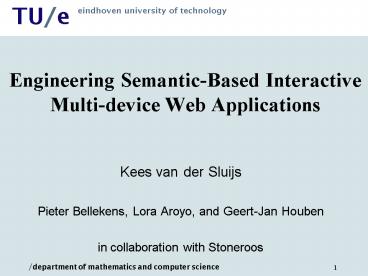Engineering SemanticBased Interactive Multidevice Web Applications - PowerPoint PPT Presentation
1 / 26
Title:
Engineering SemanticBased Interactive Multidevice Web Applications
Description:
/department of mathematics and computer science. TU/e. eindhoven university of technology ... eindhoven university of technology. 9. Chose RDF as data ... – PowerPoint PPT presentation
Number of Views:50
Avg rating:3.0/5.0
Title: Engineering SemanticBased Interactive Multidevice Web Applications
1
Engineering Semantic-Based InteractiveMulti-devi
ce Web Applications
- Kees van der Sluijs
- Pieter Bellekens, Lora Aroyo, and Geert-Jan
Houben - in collaboration with Stoneroos
2
Outline
- Identification of a growing group of Web
applications with common issues - Identification of a group of techniques that
together can help to solve those issues - All illustrated by example application SenSee
3
iFanzy / SenSee Requirements
- Personalized Web-based browser for digital
television content - Harvest program information from different
sources - Use the application on several type of machines
and platforms - Give the user control over a large source of data
4
Vision
4
5
SIM Characteristics
- Common themes within a growing number of Web
Applications - Semantics Tying in multiple semantic
heterogeneous sources - Interactive Web-browser as a platform
desktop-like-applications for individuals and
groups - Multi-Device Not PC-only, but also mobile
devices, set-top boxes, sensors and multi-location
6
Semantic Requirements Integrating Multiple
Heterogeneous Data-sources
- For SenSee
- (Live) data sources like EPGs, IMDB,
BBC-backstage - Different Formats
- Unreliable / Slow
- Ontological sources like Time Ontology, Geo
Ontology, TVAnytime genre classification, WordNet - Granularity problems
- No direct connection with data sources
7
Interactive Requirements Web-browser as an
application platform
- Web application as responsive as (good) desktop
applications (despite unreliable/slow sources)
- Application adapts and personalizes to the user,
considering the users preferences and context
- Multiple users are able to jointly use the
system - Users are offered tools to efficiently search
and explore through an abundance of information
8
Multi-Device Requirements Not PC-only
- Primary target of the application is a set-top
box and controllable by a tv-remote - User able to access the software with the pc, to
more extensively browse program and joined
information - Use of sensors is possible.
9
Content Integration Solution Choosing a data
representation language
- Chose RDF as data representation language
- Open world / Extendible
- Graph structure makes it very flexible
- Basic building blocks to tie data together
- Classification / Logic by using RDFS and OWL
- Access to multitude of Semantic Web tools
10
Content Integration Solution Choosing a database
- Using Sesame for storage and querying RDF
- Scalability (kind of)
- Powerful query languages SPARQL and SERQL
- Context
- (Custom) Inference
11
Datasets
11
12
Content Integration Solution Integrate data
sources with ontology
- TVAnytime genre-classifcation as basis
vocabulary (used by BBC) - RDFized TVAnytime
- Not only syntactically, but also added
cross-links with SKOS - Used wrapping techniques to transform EPGs to
TVAnytime-RDF - Connect TVA-time specification to OWL-time for
time based reasoning
programItem -publishedStartTime-gt
2007-07-21T212000Z Evening start-gt
2000 Evening end-gt 2300
13
Content Integration Solution Connecting data
sources
- RDFized IMDB dataset (multi-million triples,
13GB of data)
- Retrieved URLs photos and trailers from the Web
- Connected to Time, GEO and TVA-genre ontologies
for reasoning purposes
- Relate IMDB with EPGs by movie title in
combination with director and actor names
Buono, il brutto, il cattivo, Il (1966)
versus The Good, the Bad and the Ugly
14
Interaction Solution Improving perceived
performance
- AJAX to enable parallelization
- User actions can trigger dozens of queries
- Some content is retrieved live from the Web
- When results are known they are immediately
presented to the user - We used GWT from Google
15
Interaction Solution Integrate data sources with
ontology
- Faceted Browsing
- User can browse content via facets or dimensions
(in this case time, location, genre) - Possible because of connections made in content
integration phase
- Because use of RDF-standards new facets can be
added easily
16
Multi-Device Solution
- Web services implementation architecture
- Interfaces are shells that base their
functionality on the SenSee services - New interfaces can easily be created and plugged
in - Services include Personalization and Context
- Input Devices can also insert data via the
services
17
Multi-Device Sensor example
18
Multi-Device Gesture Recognition
19
Architecture
20
Motivation Video iFanzy
VIDEO
21
Screenshots
21
22
Screenshots
22
23
Screenshots
23
24
Conclusion
- Growing number of Web-applications with SIM
characteristics - We successfully attacked the problem in SenSee -
and some other examples - by using existing
techniques - Semantic Web
- Rich navigation by adding a few connections
- Ajax
- Parallelization through asynchronicity
- Web Services
- Interconnecting devices
24
25
Current and Future Work
- Continuous improvement iterations for commercial
exploitation - Exploring further parallelization and
optimization - Tool support to ease and speed-up the process of
building SIM applications
26
26































